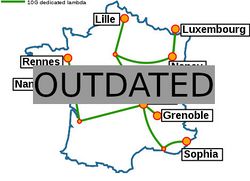Grid5000:Home
|
Grid'5000 is a large-scale and versatile testbed for experiment-driven research in all areas of computer science, with a focus on parallel and distributed computing including Cloud, HPC and Big Data. Key features:
Older documents:
|
Random pick of publications
Five random publications that benefited from Grid'5000 (at least 2927 overall):
- Cherif Latreche, Nikos Parlavantzas, Hector A Duran-Limon. FoRLess: A Deep Reinforcement Learning-based approach for FaaS Placement in Fog. UCC 2024 - 17th IEEE/ACM International Conference on Utility and Cloud Computing, Dec 2024, Sharjah, United Arab Emirates. pp.1-9. hal-04791252 view on HAL pdf
- Geo Johns Antony, Marie Delavergne, Adrien Lebre, Matthieu Rakotojaona Rainimangavelo. Thinking out of replication for geo-distributing applications: the sharding case. ICFEC 2024: 8th IEEE International Conference on Fog and Edge Computing, May 2024, Philadelphia, United States. pp.1-8, 10.1109/ICFEC61590.2024.00019. hal-04522961 view on HAL pdf
- Vladimir Ostapenco, Laurent Lefèvre, Anne-Cécile Orgerie, Benjamin Fichel. Exploring RAPL as a Power Capping Leverage for Power-Constrained Infrastructures. ICA3PP 2024 - 24th International Conference on Algorithms and Architectures for Parallel Processing, Oct 2024, Macau SAR, China. pp.1-10. hal-04742418 view on HAL pdf
- Barbara Gendron, Gaël Guibon. SEC : contexte émotionnel phrastique intégré pour la reconnaissance émotionnelle efficiente dans la conversation. 35èmes Journées d'Études sur la Parole (JEP 2024) 31ème Conférence sur le Traitement Automatique des Langues Naturelles (TALN 2024) 26ème Rencontre des Étudiants Chercheurs en Informatique pour le Traitement Automatique des Langues (RECITAL 2024), Jul 2024, Toulouse, France. pp.219-233. hal-04623019 view on HAL pdf
- Khaled Arsalane, Guillaume Pierre, Shadi Ibrahim. Toward Stream Processing Elasticity in Realistic Geo-Distributed Environments. IC2E 2024 - 12th IEEE International Conference on Cloud Engineering, IEEE, Sep 2024, Paphos, Cyprus. pp.1-9. hal-04655408v2 view on HAL pdf
Latest news
Failed to load RSS feed from https://www.grid5000.fr/mediawiki/index.php?title=News&action=feed&feed=atom: Error parsing XML for RSS
Grid'5000 sites
Current funding
As from June 2008, Inria is the main contributor to Grid'5000 funding.
INRIA |
CNRS |
UniversitiesUniversité Grenoble Alpes, Grenoble INP |
Regional councilsAquitaine |


